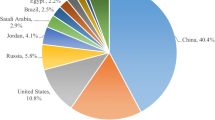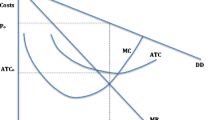Abstract
Although dominated by the forces of competition over the past 50 years, with relatively easy entry and exit of new producers and plentiful reserves, the phosphate industry and phosphate markets have experienced several interesting episodes during this period. These have been associated with the attempted establishment of a producer cartel during the mid-1970s, the significant but declining presence of state-owned production, the demise of the Soviet Union and the recent minerals boom. While noting the significance of the earlier events, the particular focus of this paper is on the events of the past two decades and likely development in the foreseeable future. The authors utilise the standard supply and demand framework developing their discussion.









Similar content being viewed by others
Notes
This statement is based on estimates using prices received by US producers and the US Producer Price Index as the price deflator. Authors such as Svedberg and Tilton (2006) have recently challenged the validity of using this approach.
During this period, phosphate producers attempted to follow the example of OPEC in establishing a cartel. Crowson (2006) provides a brief explanation of how their actions failed because of a subsequent global recession and farmers ceasing to apply phosphate fertilisers to their crops.
See for example sources such as Informine (2011).
Though Jordan is not one of the four major phosphate rock-producing nations, its production data are typically representative of all producers. The availability of these data to the authors made its use in various parts of the paper attractive to illustrate points in our argument.
British Sulphur Consultants (2006) ranked mines in Florida, Morocco, China and Australia as low cost producers. Medium-cost producing mines were located in Jordan, Israel, Brazil, Russia, Tunisia and Senegal. High cost producers were in South Africa, Togo, Idaho and Utah.
References
British Sulphur Corporation (2004) Phosphate rock, annual report. CRU, London
Clifford P, Michael G, Lloyd J, Zhang P (1998) Technology research improves phosphate economics. Min Eng 50(2):46–51
Cordell D, Drangert J-O, White S (2009) The story of phosphorus: global food security and food for thought. Glob Environ Change 19:292–305
Crowson P (1998) Inside mining. Mining Journal Books, London
Crowson P (2006) Minerals markets, prices and the recent performance of the minerals and energy sector. In: Maxwell P, Guj P (eds) Australian mineral economics. Australian Institute of Mining and Metallurgy, Melbourne
Euro-Mediterranean Free Trade Zone 2000. Implications for sustainability. Available at http://www.foeme.org
Heffer P, Prud’homme M (various years) Fertilizer outlook. IFA Annual Conference
Heffer P, Prud’homme M (2008) Medium-term outlook for global fertilizer demand, supply and trade, 2008–2012. In: IFA Annual Conference, 76th, Vienna, Austria, 19–21 May, Proceedings: Paris, International Fertilizer Industry Association, 11 pp
Informine (2011) Infomine website. Available at http://www.infomine.com/chartsanddata
International Fertilizer Association (1999) Fertilizer strategies. Available at http://www.fertilizer.org/ifa/form/pub_srch.asp
International Fertilizer Association (2011) Statistics. Available at http://www.fertilizer.org
Jasinski SM (2007) Phosphate rock. In: Minerals yearbook 2006, chapter 56. United States Geological Survey, Washington
Jasinski SM (2008) Phosphate rock. In: Minerals yearbook 2007, chapter 56. United States Geological Survey, Washington
Jordan Phosphate Mines Company (2006) Jordan Phosphate Mines Company Annual Report. Jordan Phosphate Mines Company, Amman
Jordan Phosphate Mines Company (various years) Jordan Phosphate Mines Company Annual Report. Jordan Phosphate Mines Company, Amman
Kauwenburgh V, Steven J (2001) Cadmium and other potential hazards. Fertilizer International, p 51
Khangaldyan N (2005) Phosphate producers address the challenge of change. Fertilizer International 406:80
Litke DW (1999) Review of phosphorus control measures in the United States and their effects on water quality. US Geological Survey, Water Resources Investigations Report 99-4007
Lundgren N-G (1996) Bulk trade and maritime transport costs. Resour Policy 22(1/2):5–32
Rawashdeh R (2007) Phosphate and the Jordanian economy: an analytical study. Unpublished Ph.D. thesis, Curtin University of Technology
Sohn I (2006) Long-term projections of non-fuel minerals: we were wrong, but why? Resour Policy 30:259–284
Steen I (1998) Phosphorus availability in the 21st century: management of a non-renewable resource. Phosphorus Potassium 217:25–31
Stewardson R (1992) Expanding value added mineral exports to Asia: value adding in Australia. In: National Agricultural and Resources Outlook Conference, Canberra, 4–6 February
Svedberg P, Tilton J (2006) The real, real price of nonrenewable resources: copper 1870–2000. World Dev 34(3):501–519
Tilton J (1992) Economics of the mineral industries. In: Hartman HL (ed) SME mining engineering handbook. SME, Littleton
Tilton J, Landsberg H (1999) Innovation, productivity growth and the survival of the U.S. copper industry. In: Simpson RD (ed) Productivity in natural resource industries; improvement through innovation. Resources for the Future, Washington
United States Geological Survey (various years) Mineral commodity summaries—phosphate rock. Available at http://www.usgs.gov
United States Geological Survey (various years). Minerals yearbook
World Bank (2011) World Bank Web page. Available at http://www.worldbank.org
World Bank (2008) Commodity price data. Available at http://www.worldbank.org
Author information
Authors and Affiliations
Corresponding author
Rights and permissions
About this article
Cite this article
al Rawashdeh, R., Maxwell, P. The evolution and prospects of the phosphate industry. Miner Econ 24, 15–27 (2011). https://doi.org/10.1007/s13563-011-0003-8
Received:
Accepted:
Published:
Issue Date:
DOI: https://doi.org/10.1007/s13563-011-0003-8




